If you are a summertime trout stream fly fisher you will know the scenario about to be described all too well. You get to the stream armed with your favorite hopper or ant pattern. Or maybe a Sulphur/ BWO emerger on a big icy cold tailwater. And as you walk the banks you see little white clouds of vertically dancing bug frenzies along the banks -they are super tiny bugs mind you. You dismiss them as tiny gnats/midges that the trout surely can’t be preoccupied with. Then one lands on your arm and sticks to your insect repellant or sweat. And their it is!- the tiniest little black bodied/tall, clear winged mayfly you have ever seen.
As you look downstream you start to see the rising dimples. First just a few, then they are everywhere. You surely think they are perhaps just chubs or small parr, but just then you catch a glimpse of a big bulging riser that moves water to push another small dimpling riser out of the way-Yup!, a big trout marking its territory and feeding lane! The Trico spinner fall has started. Are you ready to match this vexing hatch?
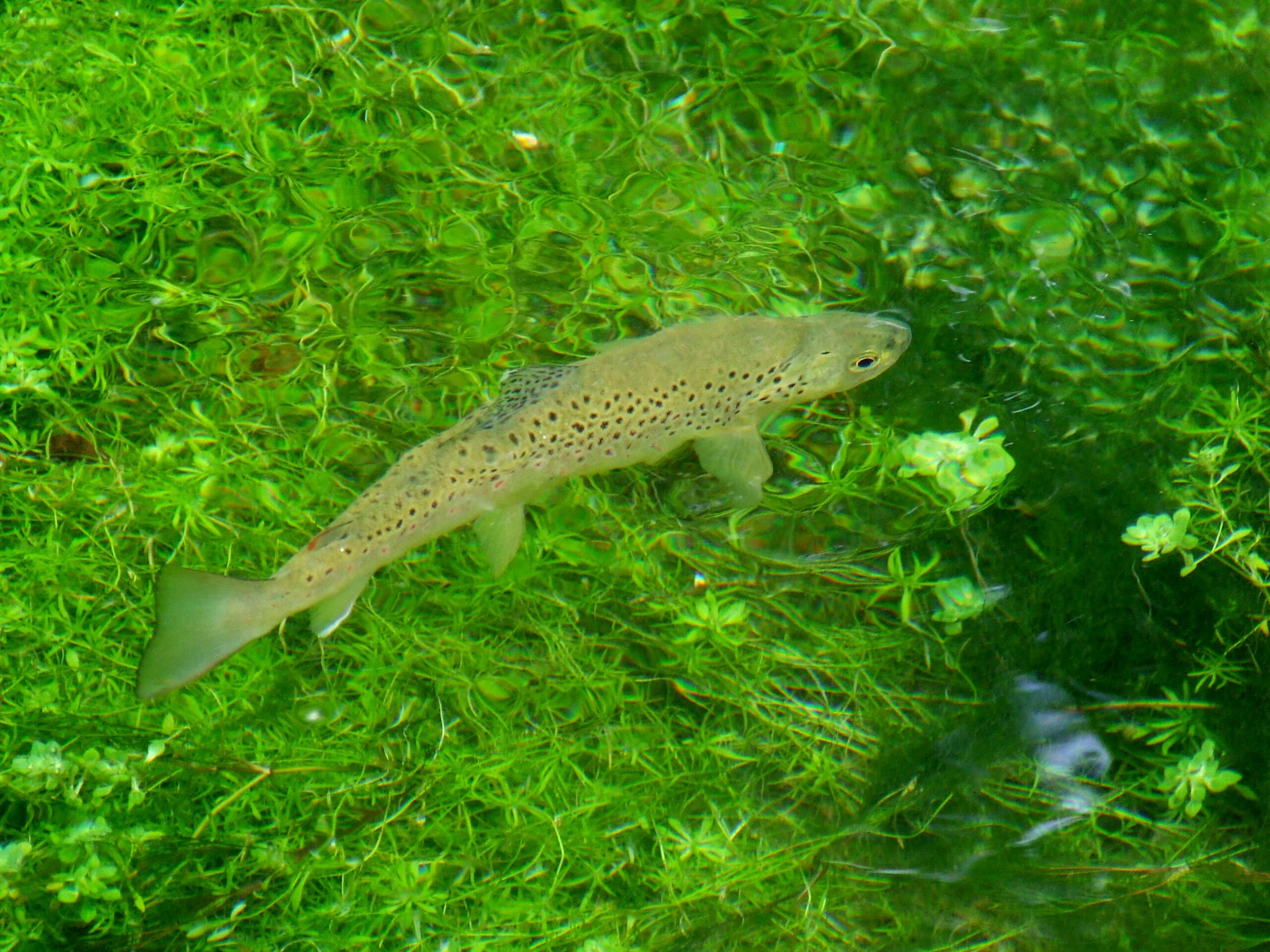
THE EARLY RISER TREAT
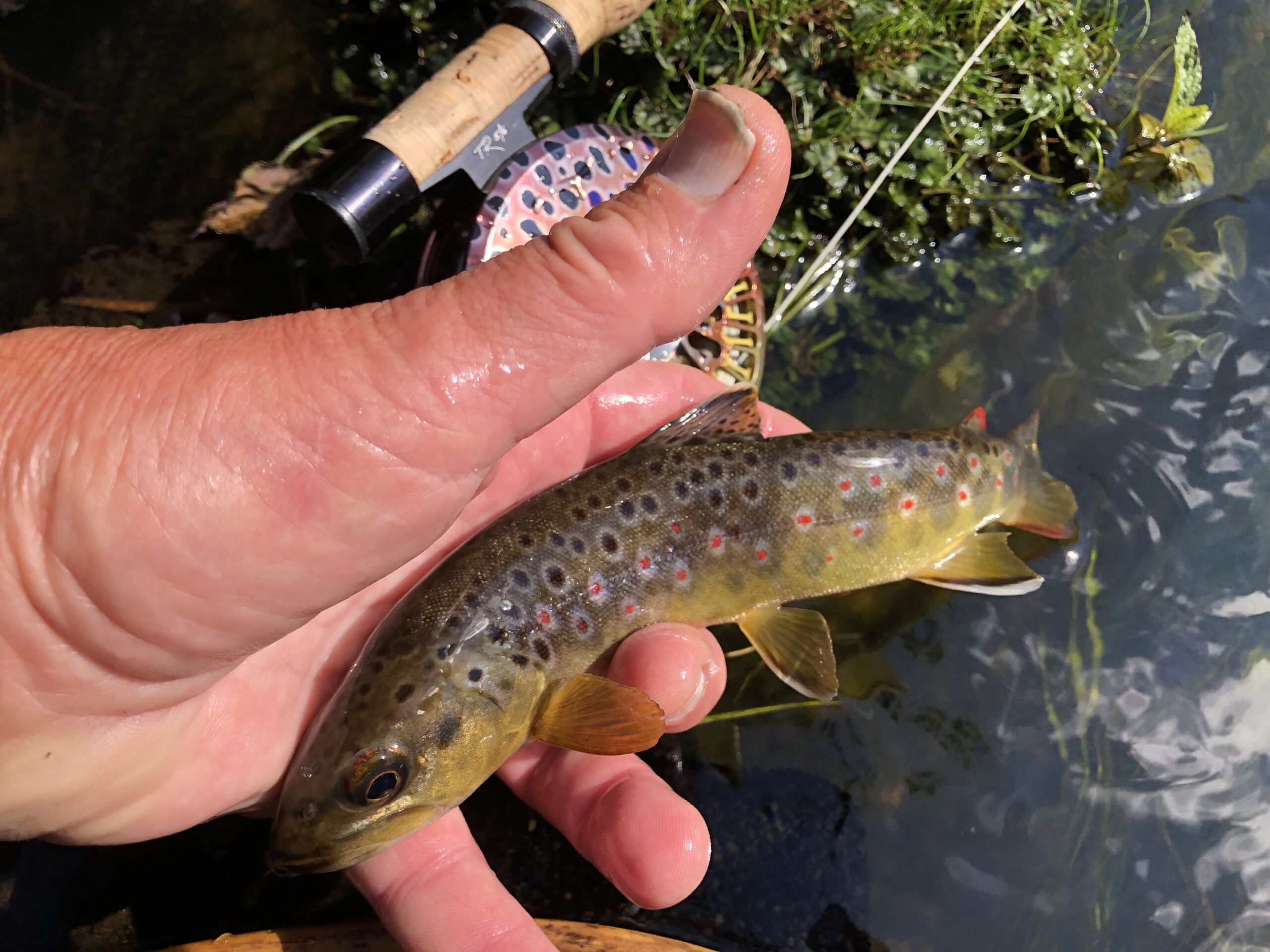
EARLY CHRONICLES OF THE CURSE
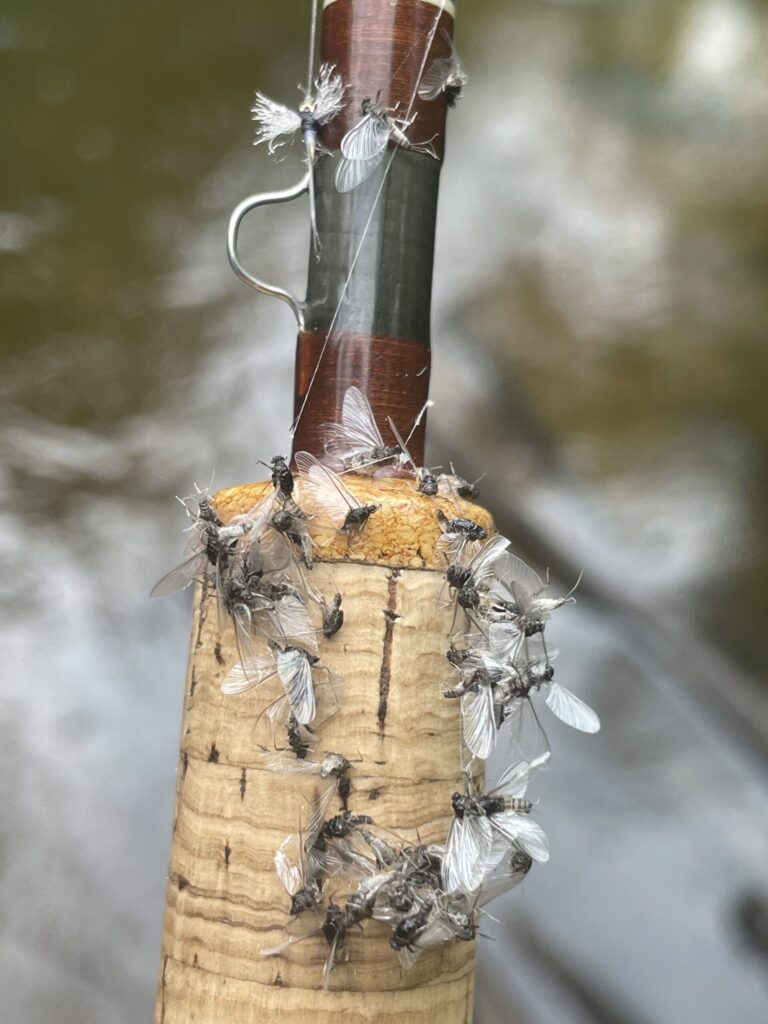
The British chalk stream fly fishers and authors took the dry fly game to the highest and most purist level. The dainty little spring creeks of Hampshire like the Rivers Test and Itchen, had lovely Ephemerella mayfly hatches of Blue Duns, the Pale Watery and of course the big mayfly royal of them all- “The Mayfly”, or Ephemera danica. With an iconic lineage of GOAT giants that laid down the foundation of the dry fly and nymph template: Halford ,Skues and Sawyer, the tiniest of the tiny mayflies was not given much due. Perhaps it is because seasoned older gentlemen were not good with eyesight and modern optometry was not at its highest level yet.
If you are not out chasing “things that go bump in the night” for big browns with mice and Hex patterns, which is the current rage, the early morning riser trout bums have many benefits to reap. As I get older the late-night jaunts get a little more difficult on the bio clock. Also if you are a true friend of the trout and their survival, the coolest water temps are in the mornings before noon. Those late night temps can be lethal to trout-especially big ones that put-up stronger battles and have a larger body mass to support blood oxygen requirements. Night fishing without a temperature gauge can be deadly as in mortality to the trout, since the hot summer days don’t see water temperatures cool until well after midnight. One of the greatest proponents of the night stalker game is my good friend Tommy Lynch-aka “Mice Master”, and he constantly makes fly anglers aware of water temperatures.
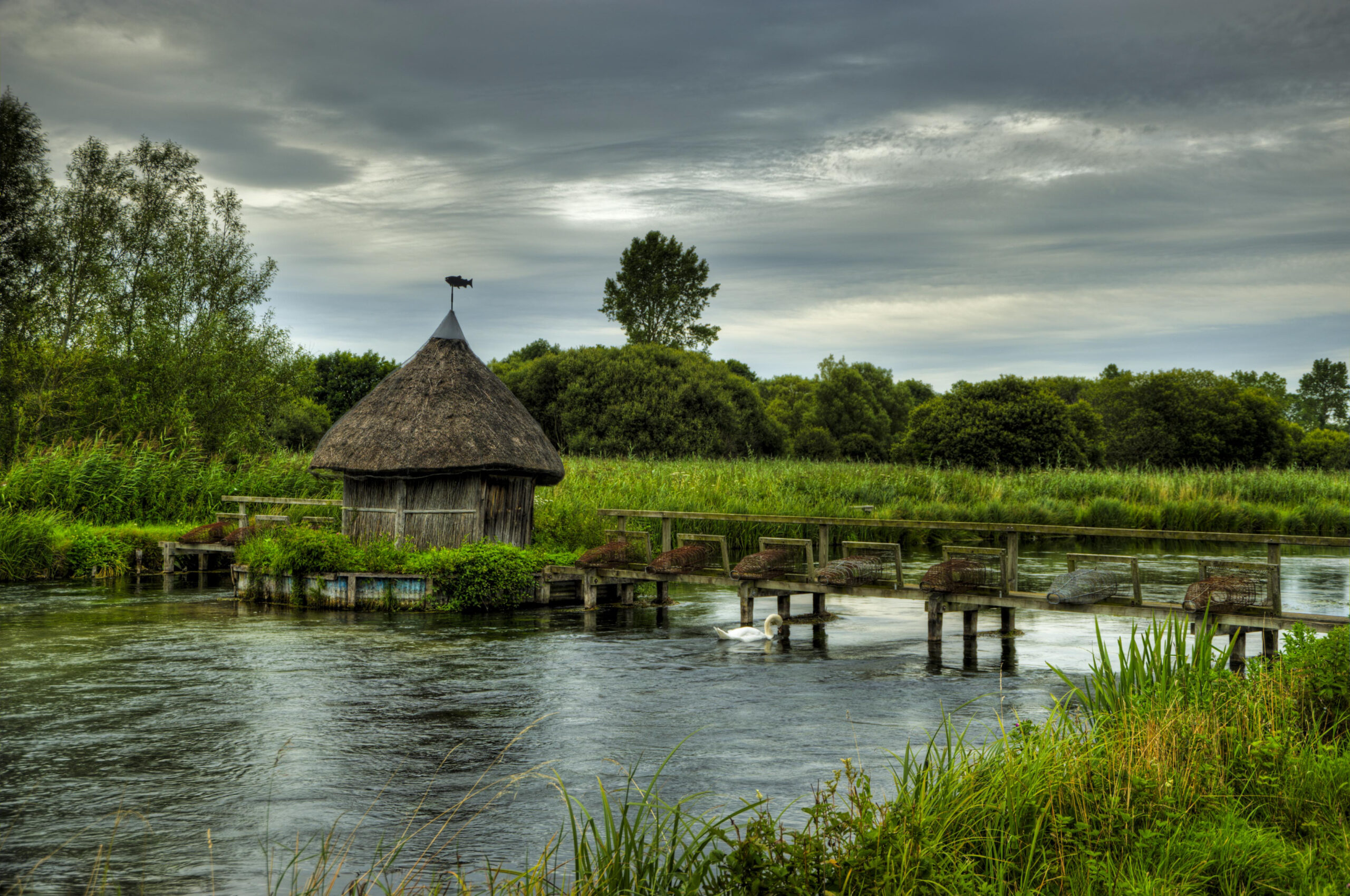
So why such little love given to these astronomical in numbers, but minute sized mayflies? The reasons are many. The Brits called them ” the white curse”, due to their snow-like blizzard clouds which would often set chalk stream trout into sipping feeding frenzies. This occurred just about the same times the olives and watery duns would make their daily appearances. In tradition, which still holds much value in the U.K. today, fishing hook sizes smaller than #16-18 was considered rubbish and fool’s play. Though Buzzers and Chironomid fly patterns have been revolutionized by the Brits on Stillwater, primarily due to the larger midges found there that average size 14-18’s, the minutiae of trout streams has never been fully internalized.
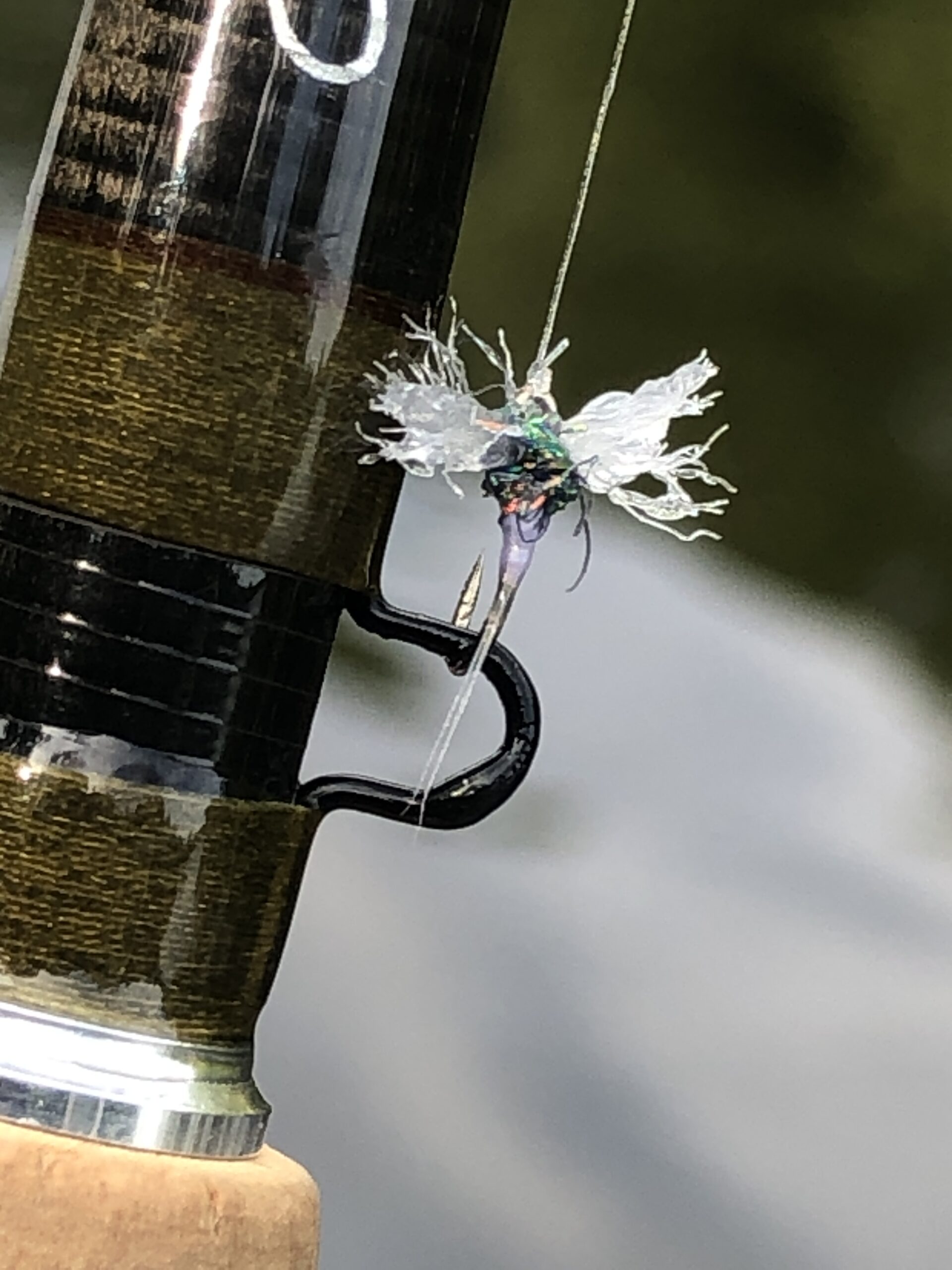
I caught my first Trico brown on July 4th when I was 16 years old. It was on a Wyoming County/ New York tiny coy fusion spring creek. It happened as I was just about to leave and call it a “skunked” trip. As I noticed a nice steadily rising bulge under a bankside willow tree in a very nice pool, I reached into my fly box for the new dope. My Cahills and Grey Fox patterns weren’t cutting it that day and I was lucky to have to tucked away in my vest a couple micro tiny spinner patterns the local Orvis shop in Buffalo said was the fly of the week- called “Caenis” ( ( I couldn’t begin to tie flies that small since I couldn’t barely find hooks so tiny back then) It was a beautiful small kyped-jawed wild brown of about 16 inches that gave me one hell of a battle! I then began to read my bibles like “Selective Trout” and any information I could read. But before all the modern bibles on mayflies by Caucci/Nastasi, Swisher/Richards and Arbona came along, a very important mayfly bible reference book was somehow at my N.Y. library ( the librarian’s husband must have been a fly fisher) and written at Michigan Sate Entomology Dept. by Justin and Fannie Leonard in 1961. It detailed the mayflies of Michigan which apply to allover the East Coast. It had amazing sketches and micro-details on every mayfly that inhabited trout streams that would marvel the greatest bug authors. ( Author’s Note: Check out my Hallowed Waters Podcasts and the latest episode of “The Mayfly Mystique and Saga”-with the iconic Al Caucci of “Hatches” Book” fame- we Trico talk!
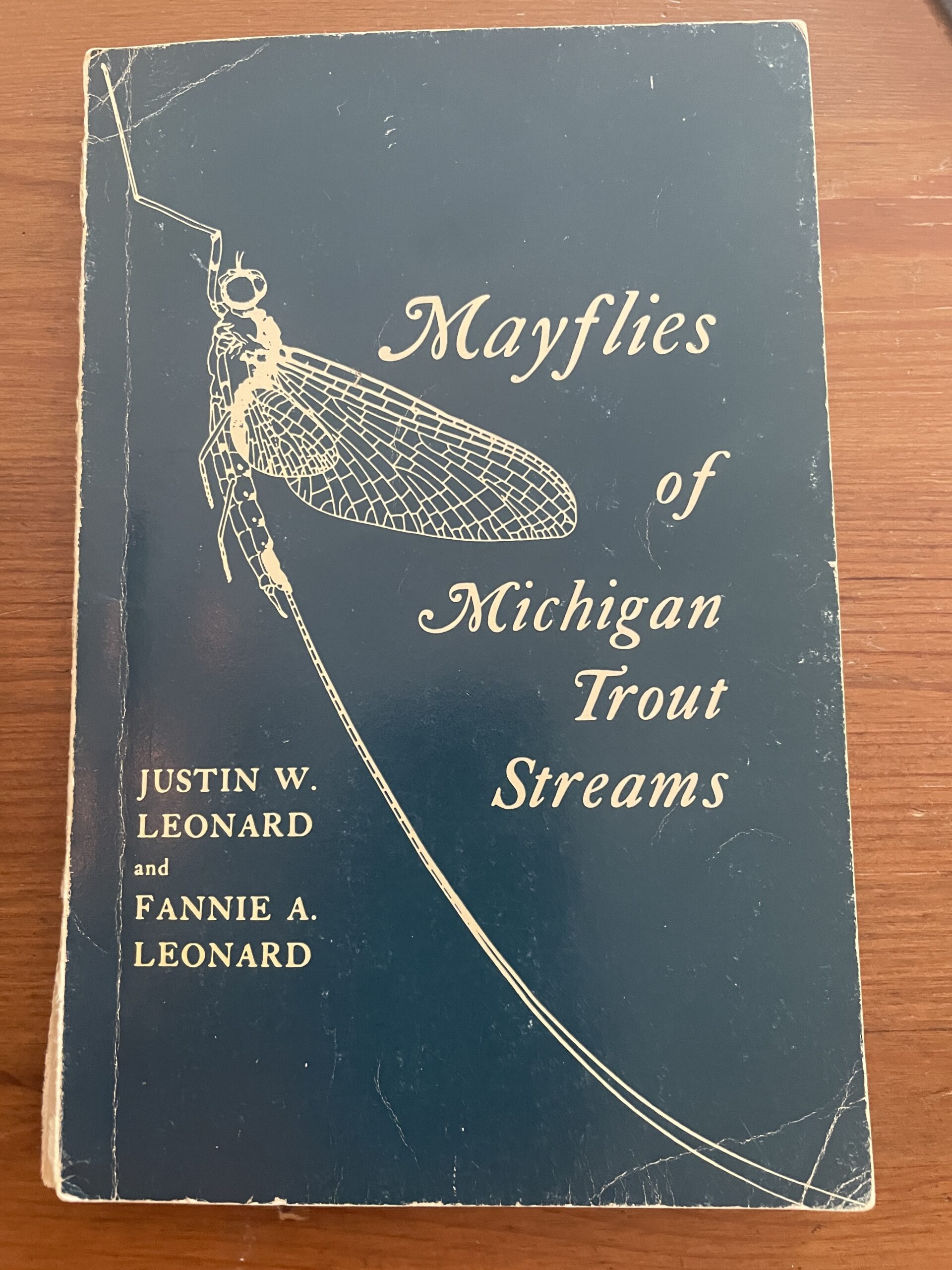

The other obstacles to fully exploring the dynamics of the Trico hatch are a matter of misconception and timing. It was thought that only small trout parr feed on the miniscule size #22-24 mayflies. But as we know trout well over 20 inches feed and devour up to a thousand or more Tricos in a single morning, and do it consistently every day.
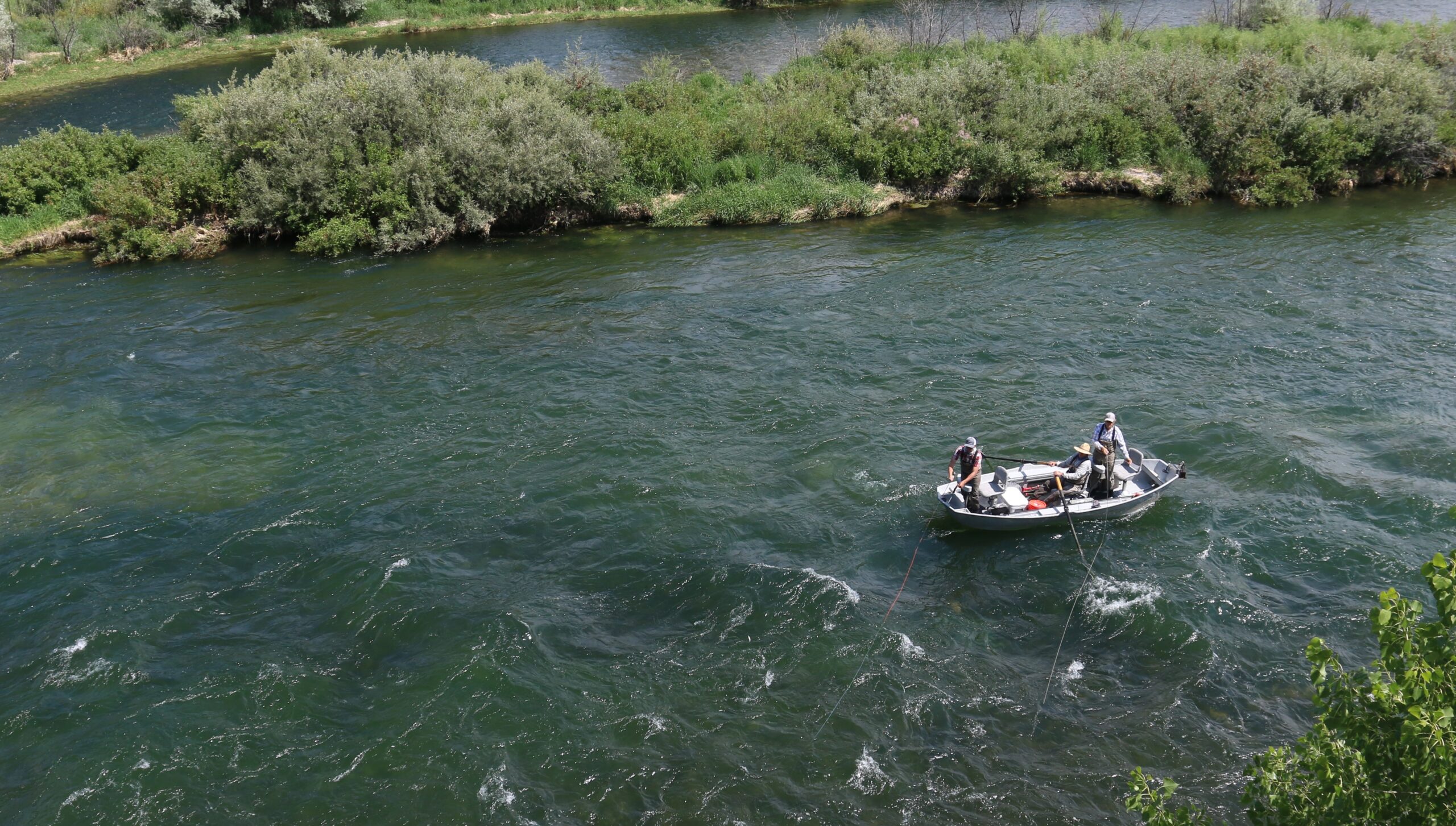
PAVING THE WAY
It wasn’t until the late 60’s and early 70’s did anglers’ start to pay attention to this hatch. With trout seasons now extending past older June and July cut-off dates, Tricos and Terrestrials where now being focused on since most of the big mayfly hatches were done for the year. It was my mentor Vince Marinaro, of Pennsylvania limestone spring creek fame, that brought the fly angling world to attention in the late 60’s with an article on the “Hidden Hatch” for Outdoor Life and its then editor Joe Brooks. It was first labeled as “Caenis” and then later became identified to the three genus of the Caenidae family.

Vince loved his favorite Letort which had some decent Trico hatches particularly in the lower stretches. But it was the Falling Spring Run near Chambersburg that had mind-boggling hatches of Tricos back in the 50’s-60’s. With daily clouds of them from July thru October, its wild Shasta California strain rainbows and the occasional mixed in wild browns gorged on the nymphs, adults and spinners daily throughout the entire spring creek. Vince loved minutiae and when the Trico hatch was on he chased them from the Little Leigh, to the lower Big Spring Run, Clark’s Creek and every spring creek to the north around State College. On the few days I was allowed to accompany him ( I never walked ahead and always several paces back like serfs serving royalty- I also was a net boy for all practical purposes)


TRICO-OLOGY
Family Caenidae has three genus: Tricorythodes, Brachycercus and Caenis. The Trico is the most common found in trout streams in North America. On the east coast stygiatus and atratus are the most prolific. Out west it is fallax.
“The Midwest has ideal habitat for Tricorythodes. We believe the best hatches in the entire country occur in Michigan and Wisconsin. Also, the spring creeks of Pennsylvania and New York, including the lower tailwaters have abundant hatches .” ( Hatches- Caucci/Nastasi)
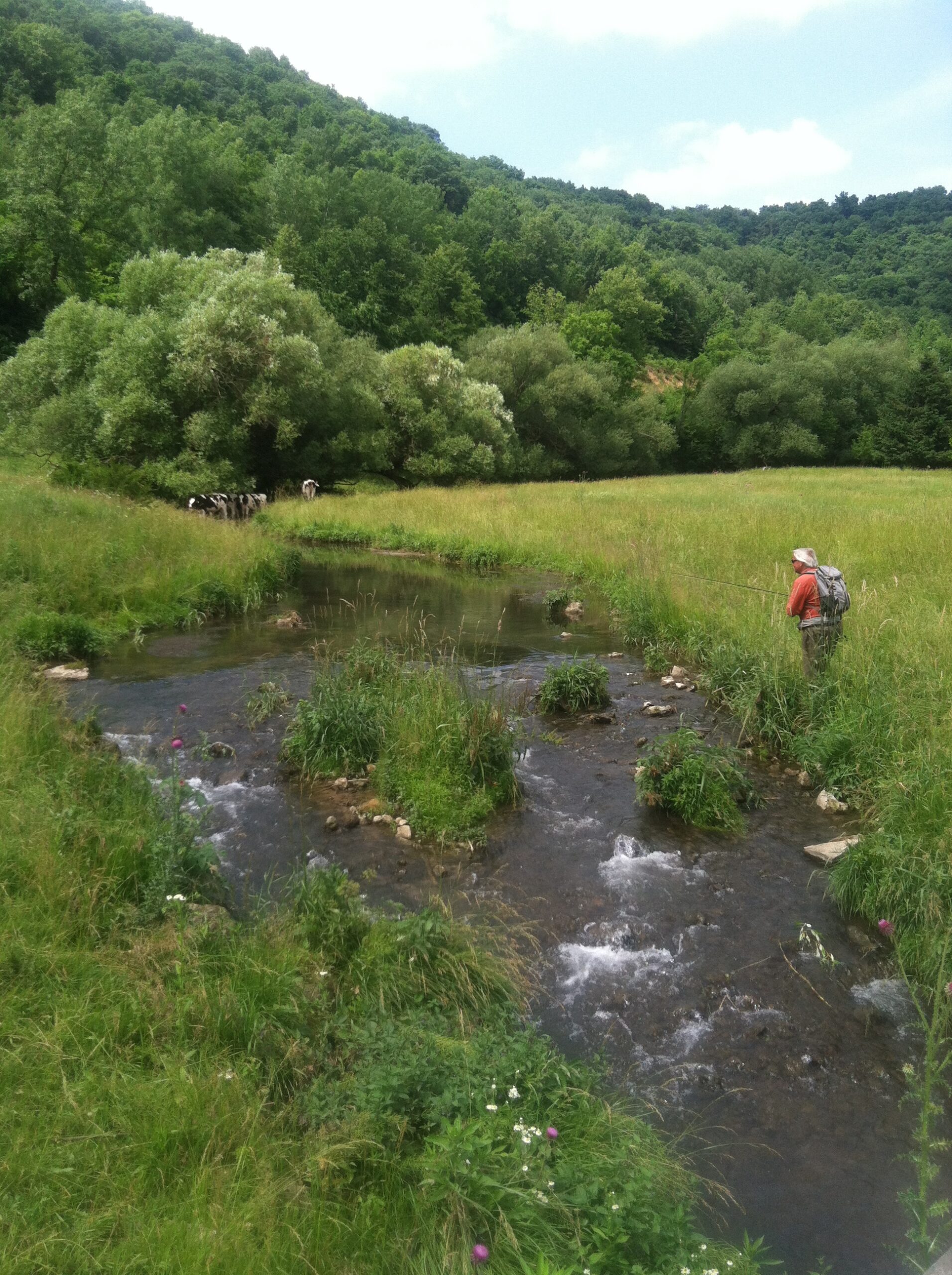
The Caenidae family are crawlers and love the gravel/weedy spring creek conditions of tailwaters, true spring creeks and the big pool and lower sections of freestoners where muck and detritus accumulate and the waters have back eddy pools that gather that habitat. Brachycercus, which look like Tricos, are predominantly a lake dwelling , warmer water loving genus. Caenis have white bodies and are practically all lake dwelling and the most minute in size down to #28. Most Trico patterns can be fished on #20-24 patterns. The nymphs measure 3 to 4 mm. The adults and spinners are the same size.
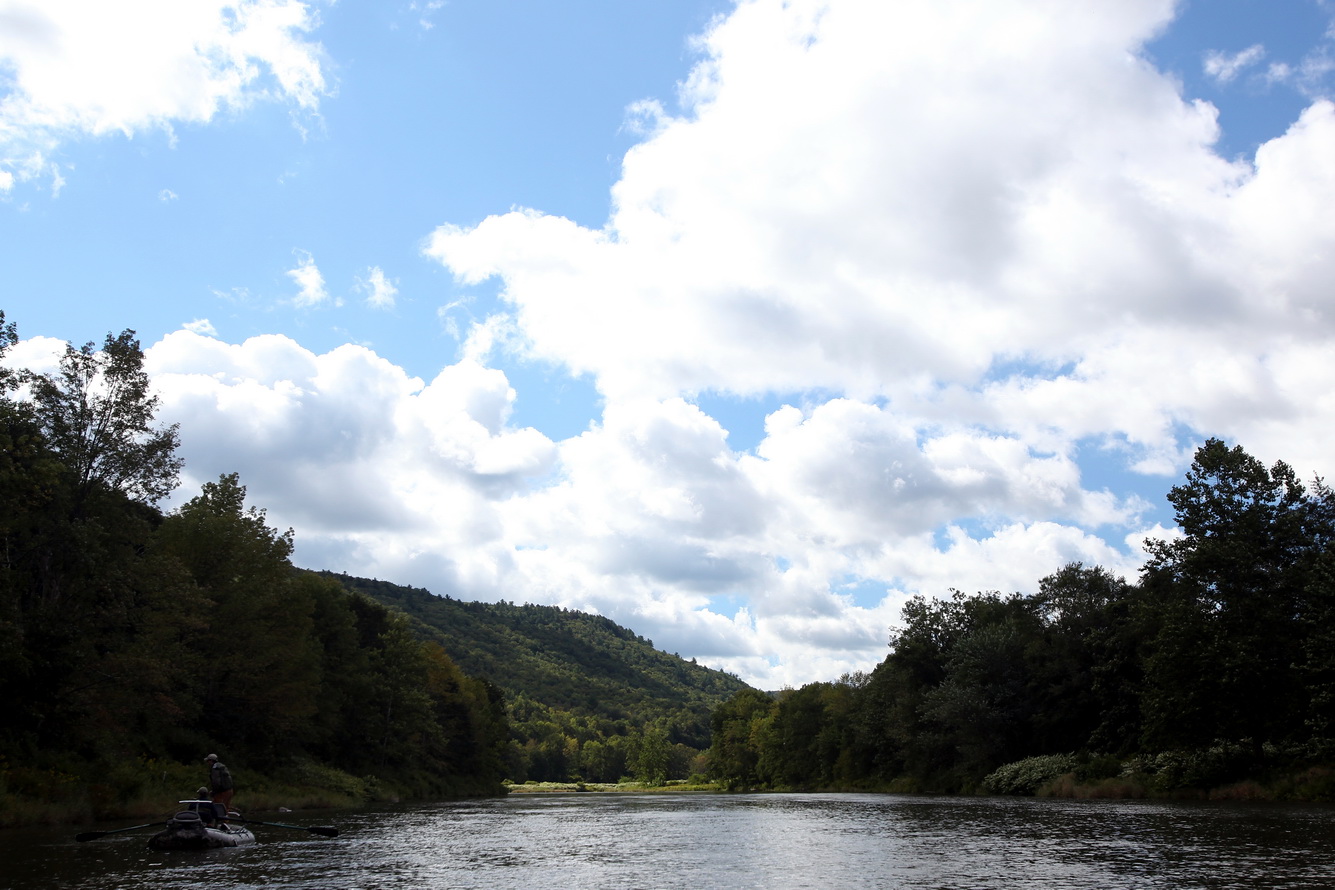
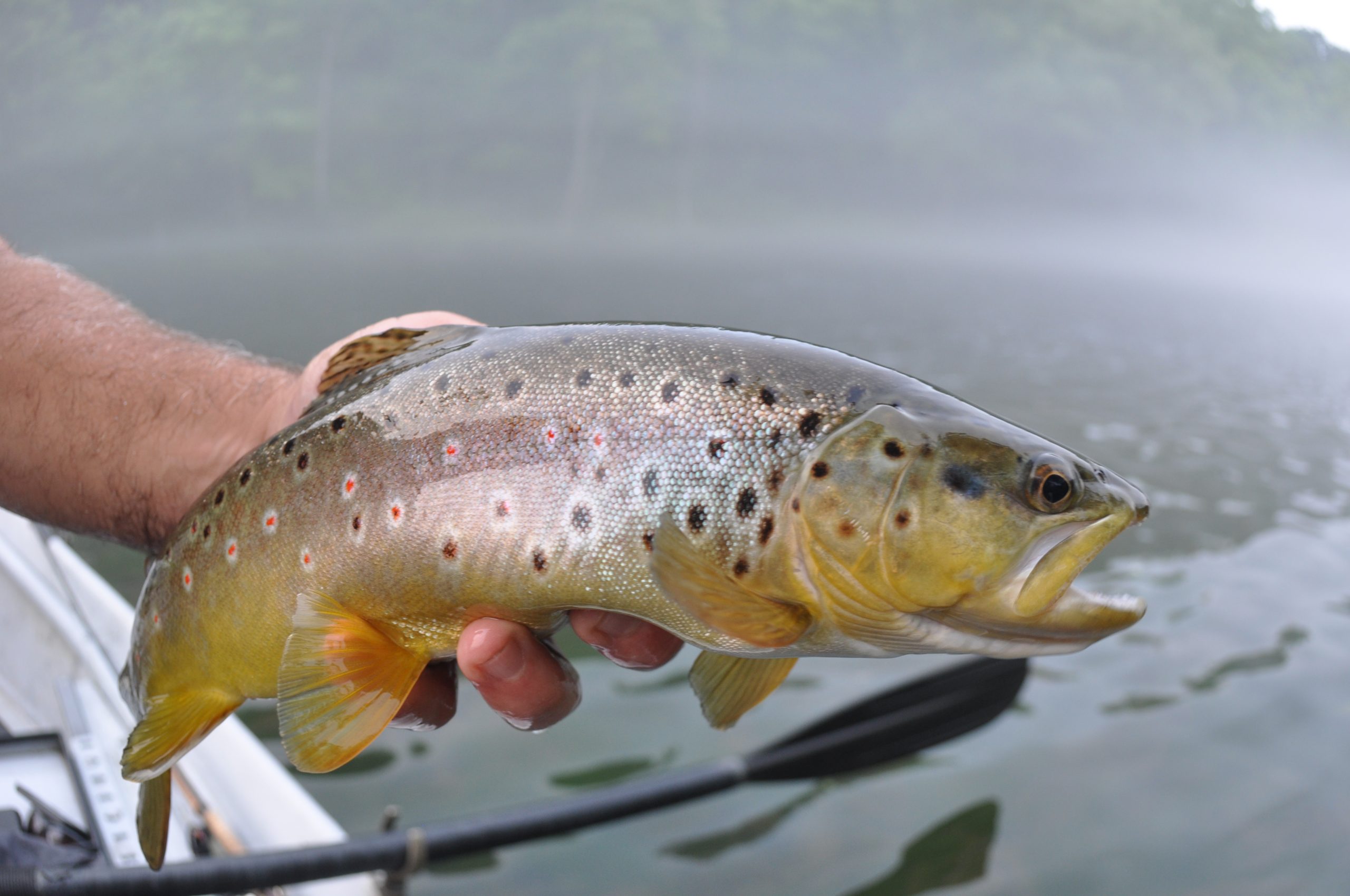
Trico nymphs’ love the marl, silt and slower moving pools. They love a slightly alkaline P.H. levels, thus spring creeks and tailwaters are their Mecca. Their bodies are a brownish black and a simple tie can imitate the nymph with black and brown biot and quills. If you are a two-three fly Euro nympher you can clean up in the sunrise dawn hours.
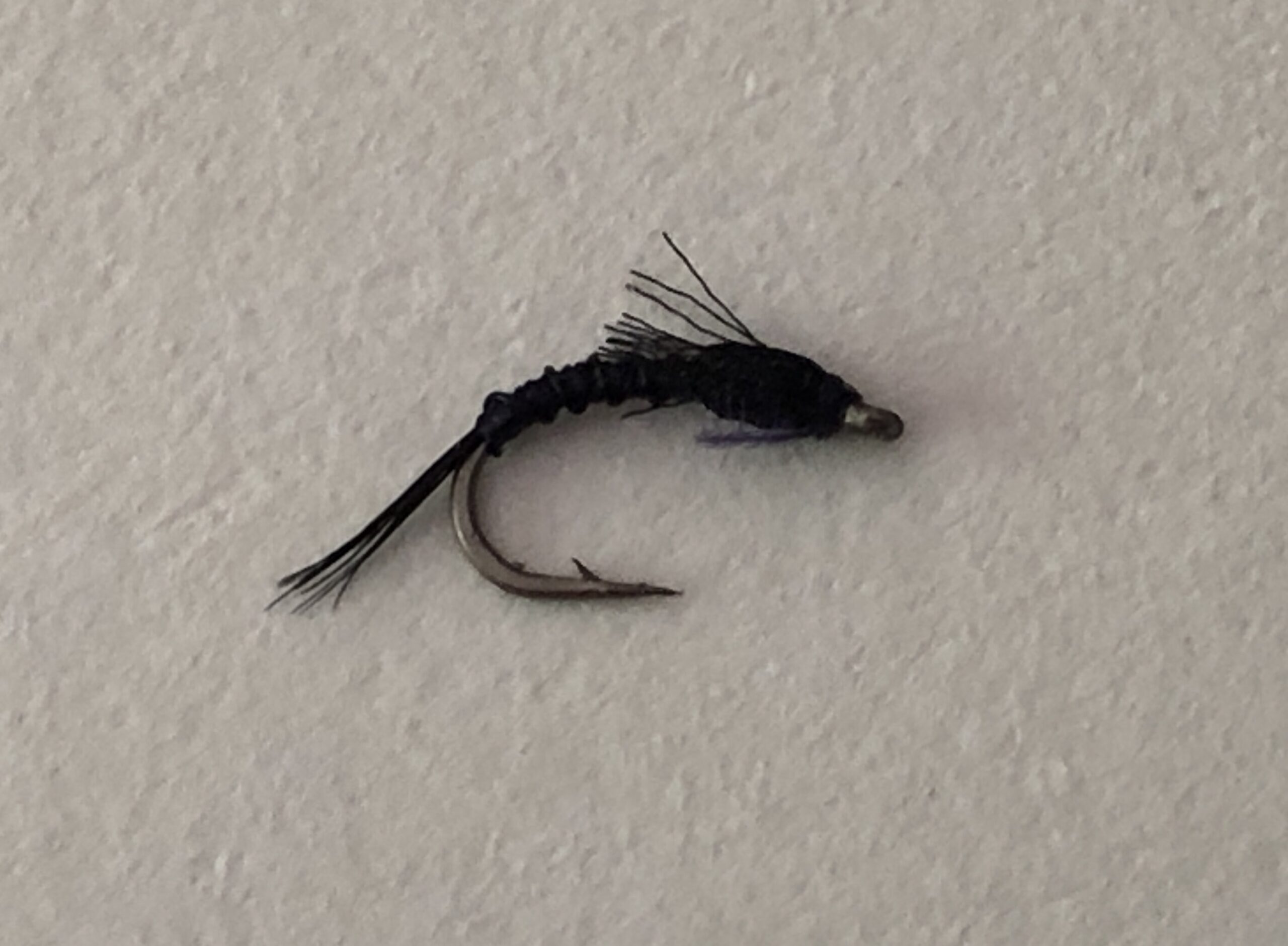
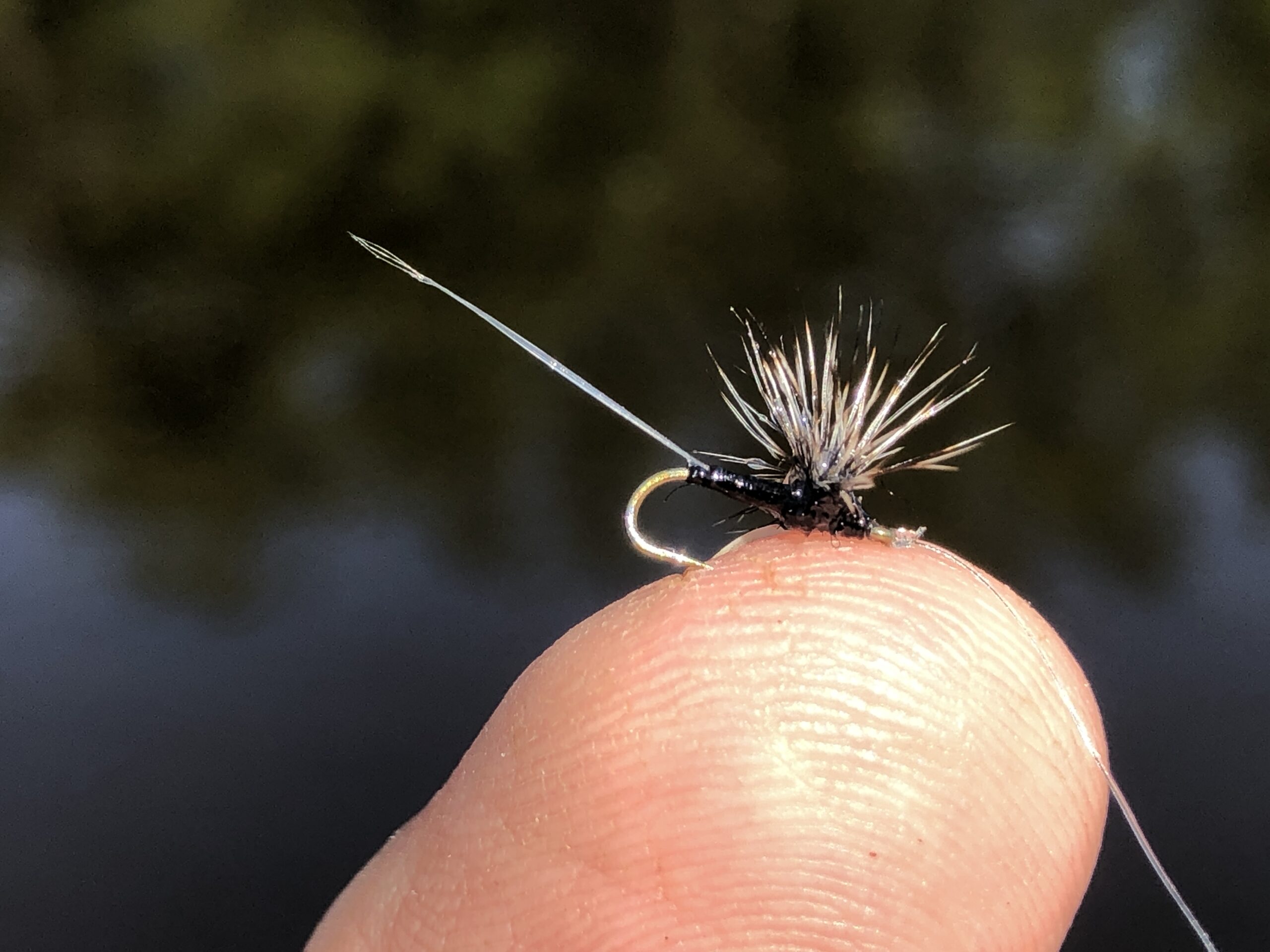
The hatch begins at dawn when million of nymphs’ crawl clumsily towards shore, vegetation and tumble down the mainstream. Hatching adult duns fly off quickly. The duns will molt to spinner subimagos within minutes on warmer, hotter days and slower up to several hours on colder high pressure mornings. The best Trico activity is on days with slight humidity and zero wind. Also massive hatches occur with the first cold front and high pressure system after a very hot weather pattern. 7 to 8 AM is the usual start of dun hatching,

The first dancing spinner mating flights will be predominantly made up of males as my butterfly net samples have indicated. This also has been verified by Caucci and Arbona. Once females enter the swarming mix the clouds of spinners tumble and gyrate into weird, conical and flatter formations as mating takes place. Spinners drop quickly and the trout head hunting game is ready to begin.
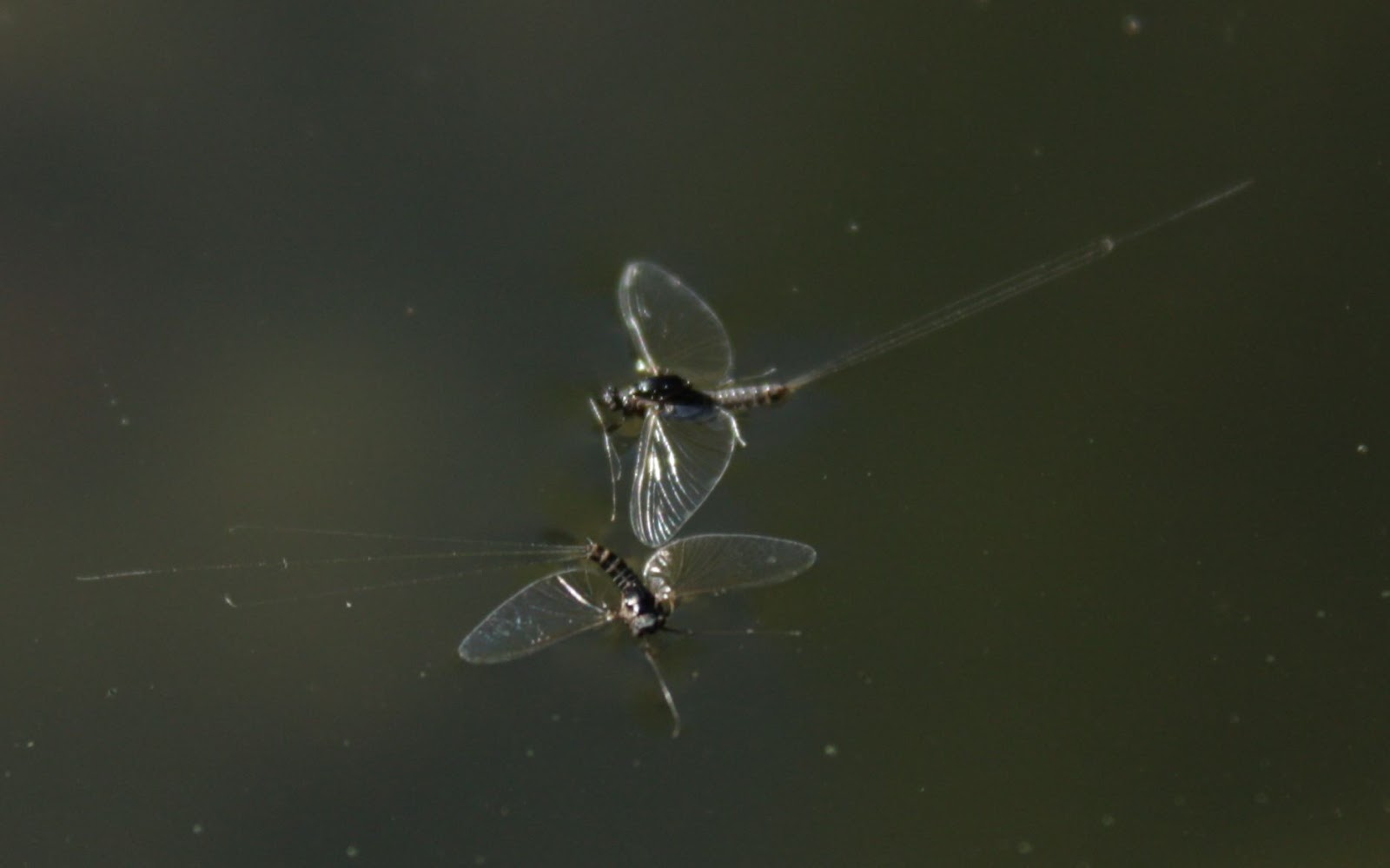
Tactical Head Hunting
The Trico game is the highest pinnacle of the dry fly experience bar none. It takes very good vision and depth perception, a sixth sense on where your fly is on the surface and meniscus and a very stealthy approach and presentation.
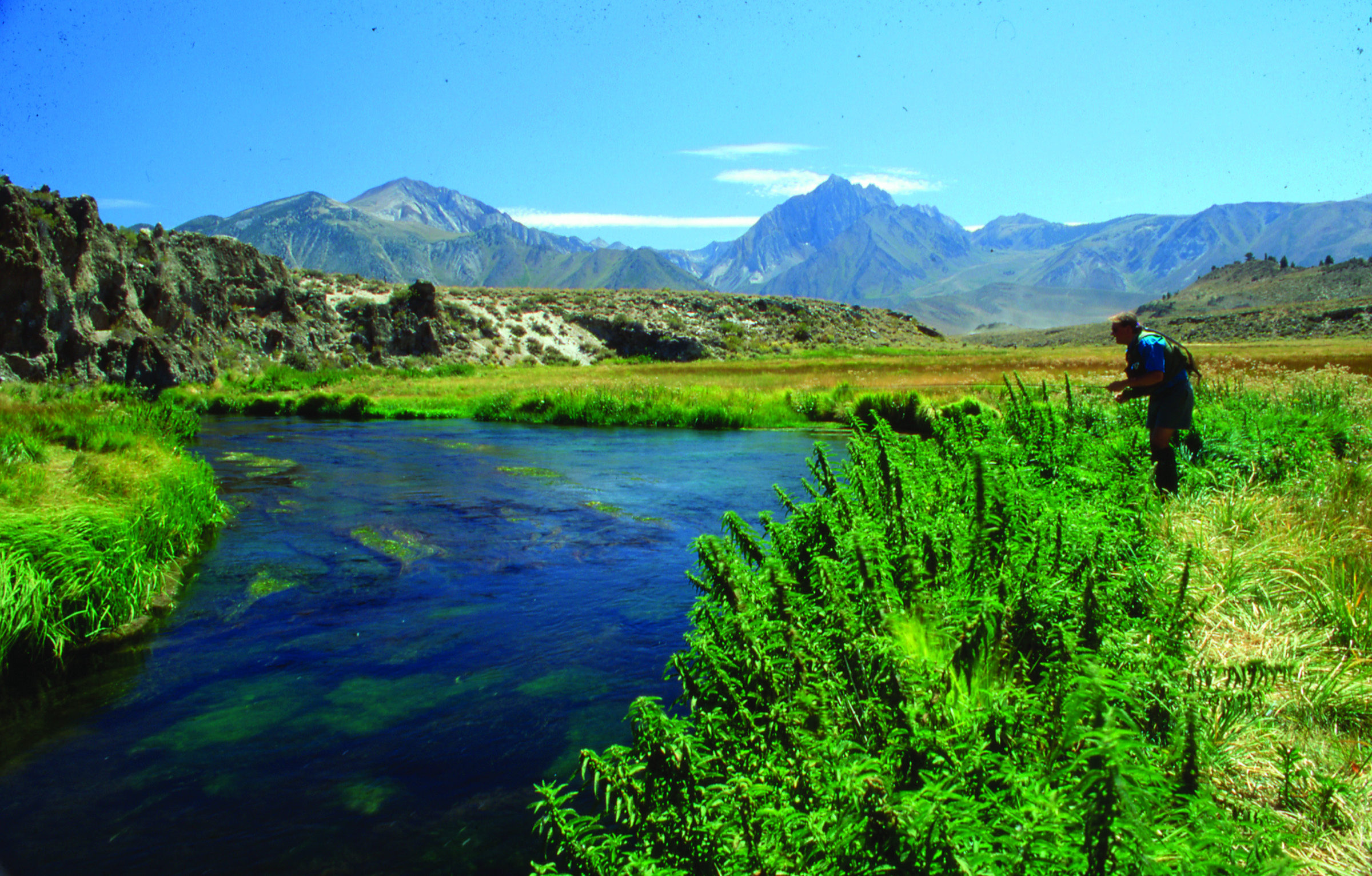
First issues are fly patterns. The biggest obstacle is hooking trout, who sometimes have boney, small kyped-jawed mouths like male browns and rainbows do. That tiny #22-24 hook doesn’t t often hold well or pernitrate to the best advantage. The older very narrow Mustad hooks had the worst potential for hooking advantage. That is why Daiichi has specialized in the new high tech minutiae hook market which Vince Marinaro started with his Partridge of England Marinaro Midge Hooks. Her they a had a wider gap that was slightly offset to the side. This will allow the best hooking advantage on trout up to and over 20 inches. Also by bending the hook gape slightly outward, you get even more hooking advantage.

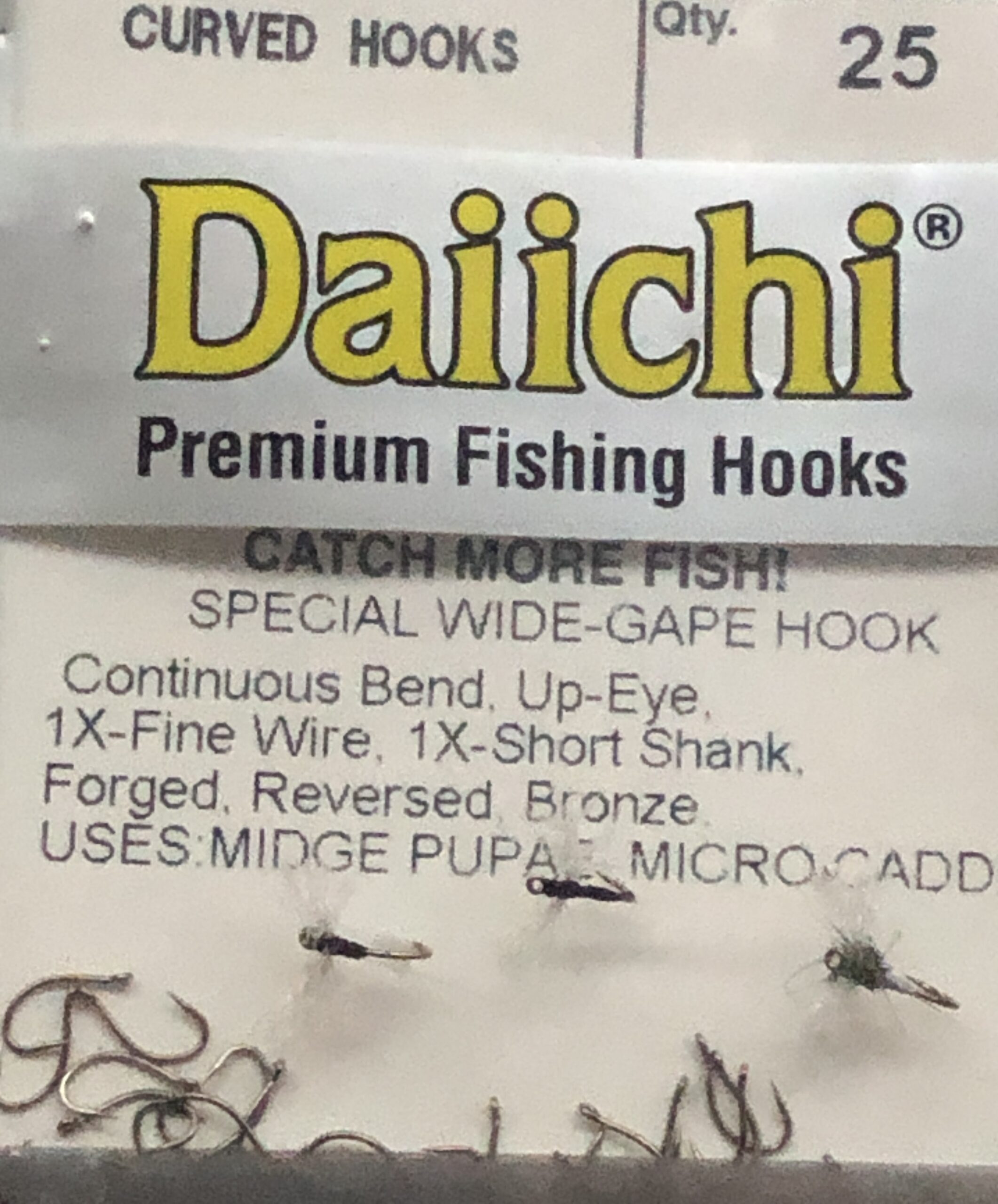
Next up is sparseness of design. Black and Trico white ( a tad grayish white) threads should form the bodies. The Female thorax can be a thin strand of peacock herl or UV Ice Dub Peacock. For wings crinkle clear Antron allows a speck of wing to stand out in the surface for vision. Organza wing material is also excellent but sits very flushed in the film. Another tactic is a puff of orange fluorescent yarn/indicator Hi-Viz material in a micro spec upward post to better see the spinner.
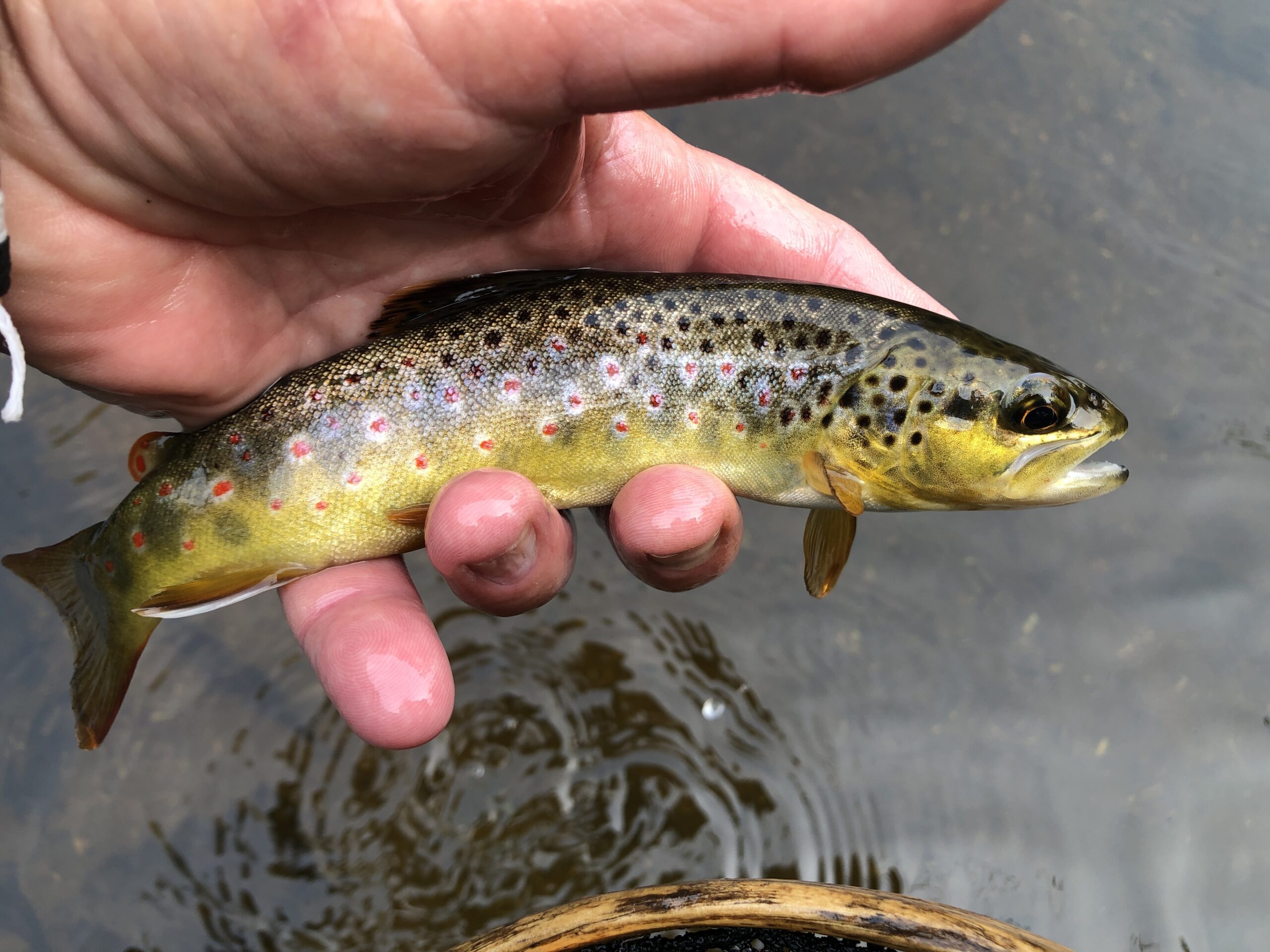
As for arsenal, long very light delicate rods are ideal if you have room on tailwaters and wide-open spring creeks. 10 and 11 footers down to 3-4 weights protect very fine 6-7x tippets and can handle bigger trout to 20 inches. On my small forested spring creeks I use 7 foot/ 2 and 3 weights. My favorite is a circa 1986 Scott G series 8 foot/8 inch 2 weight and Orvis Trico vintage graphite.
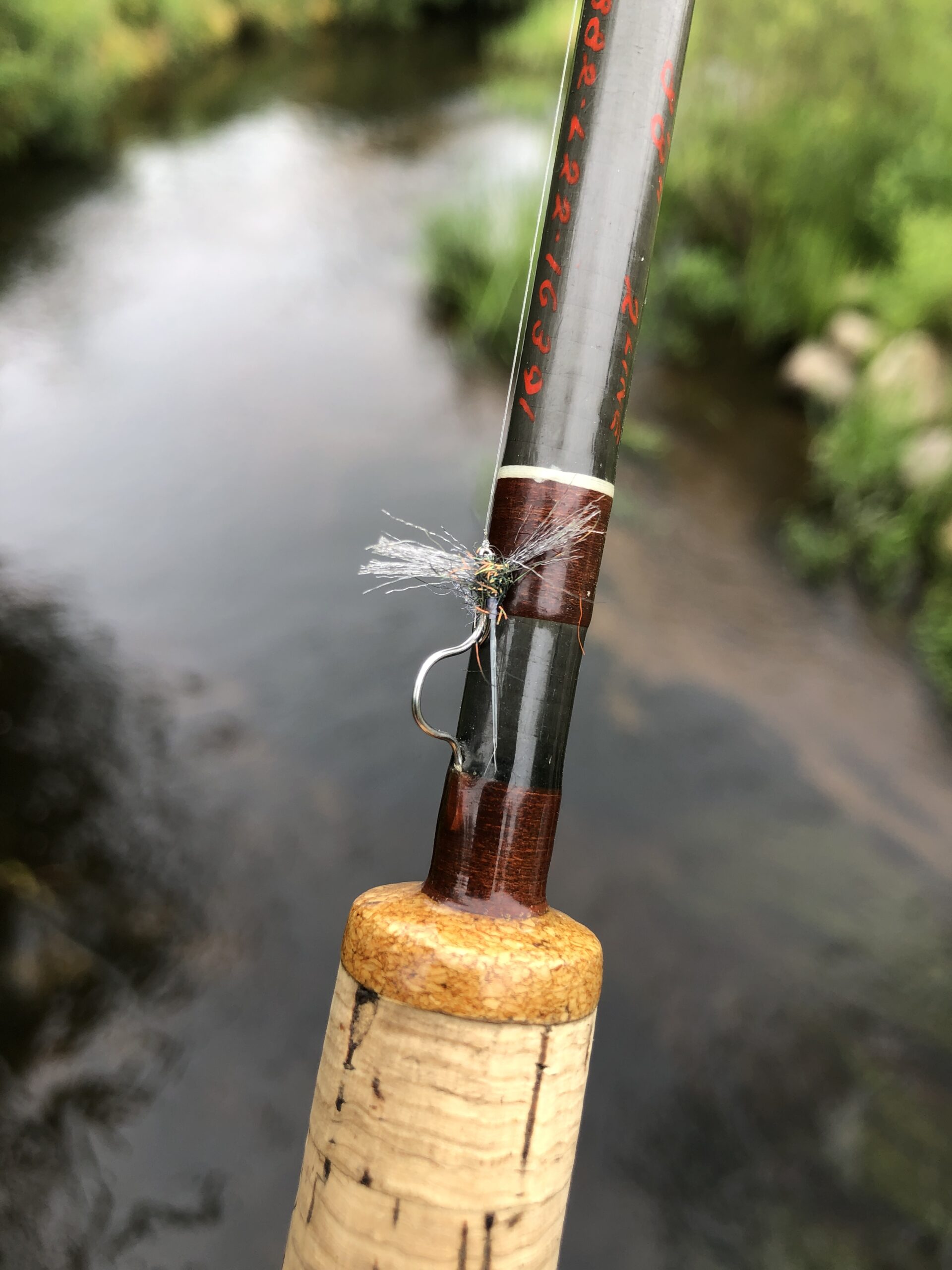
I favor very long leaders (15-18 footers) with 5 feet of 6-7x tippet. If you are fishing over very large trout on spring creeks in weedy environments, you can get away with 5x if the fish are not “super selectively sipping” ( say that fast five times! :). Maxima Chameleon and Varivas butt sections in lime/mossy green blend in stealthily, also does Orvis Super Strong. I like gray and Tan/green fly lines since you will be fishing over larger area pods of rising fish, where back-lining fish and spooking them is part of delivering the fly. A very bright line spooks fish along with very sloppy deliveries of casts on short stiff rods.
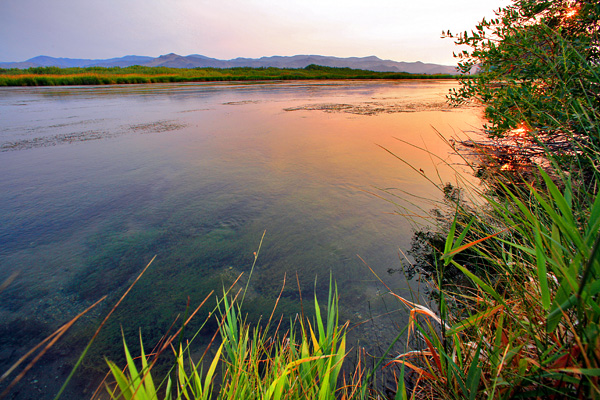
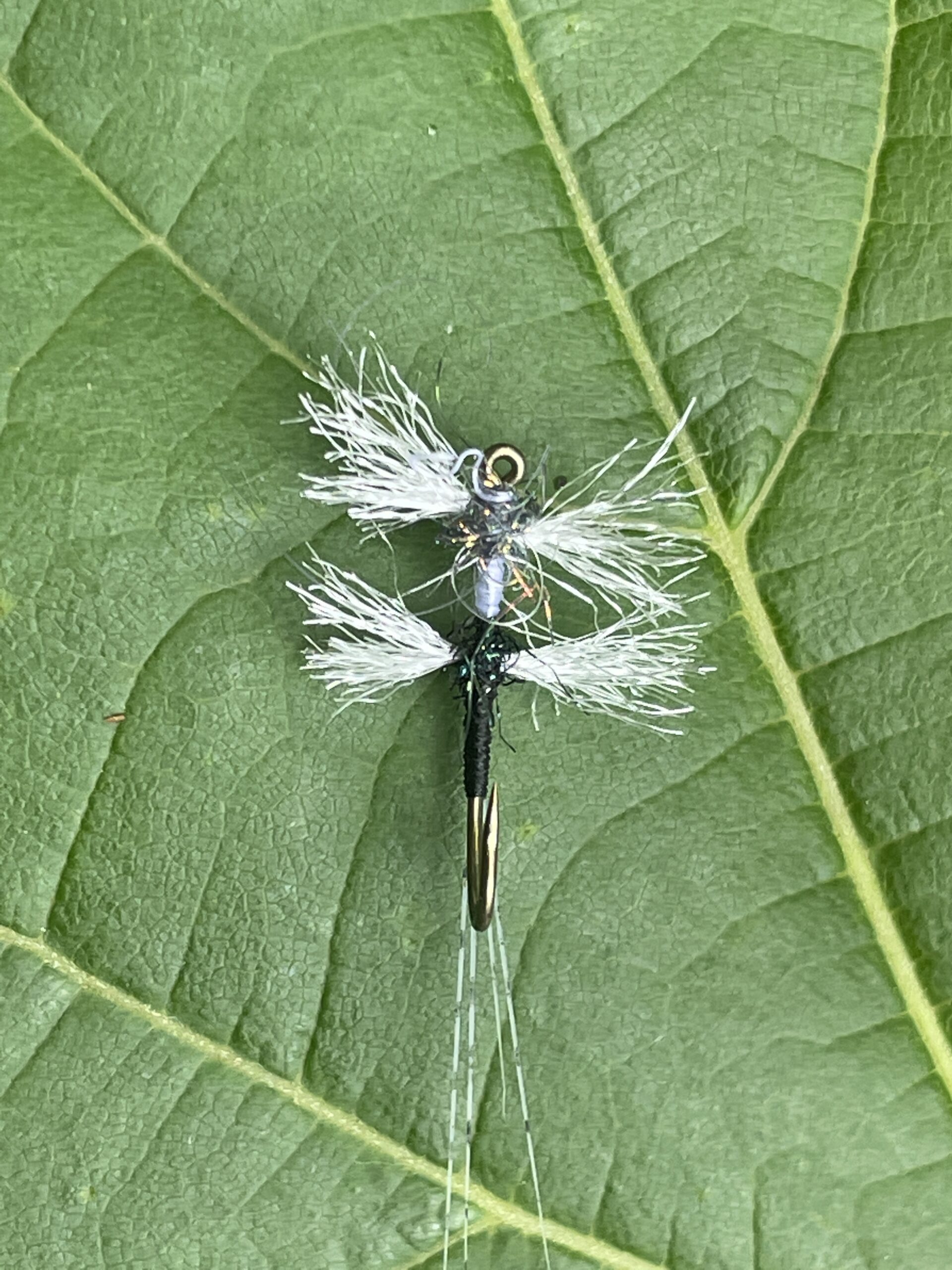
When stalking trout, if you are looking for that one special fish visually measure the bubble size and bulging of the rise form to distinguish the best fish. Often you will see the mouth gulp on very clear spring creeks and the entire rise and body size. Big trout usually command the best feeding lanes and most often smaller trout wont be rising next to them. Spend more time observing than casting. When fish are in a feeding frenzy they will be difficult to put down. The bigger trout will also be closer to cover like overhanging banks, undercut banks, wooded debris structure or a cattle/ foot /tractor crossing bridge in a pasture. On tailwaters and big freestoners they will be the tail-outs of larger pools and eddy’s.
When head hunting stick with one good trout and don’t hop cast from one fish to the next. If possible use down-and-across reach casts to allow the fly to come into the fish’s window before tippet and leader. Walk very slowly and carefully- one step at a time. Fish that are Trico feeding on spring creeks are very spooky since they are often in very shallow waters. If from a drift boat, anchor first and sit for a long time before you start casting. The boat will shift the current lanes and wait for the trout to settle into the new feeding lane regimes.
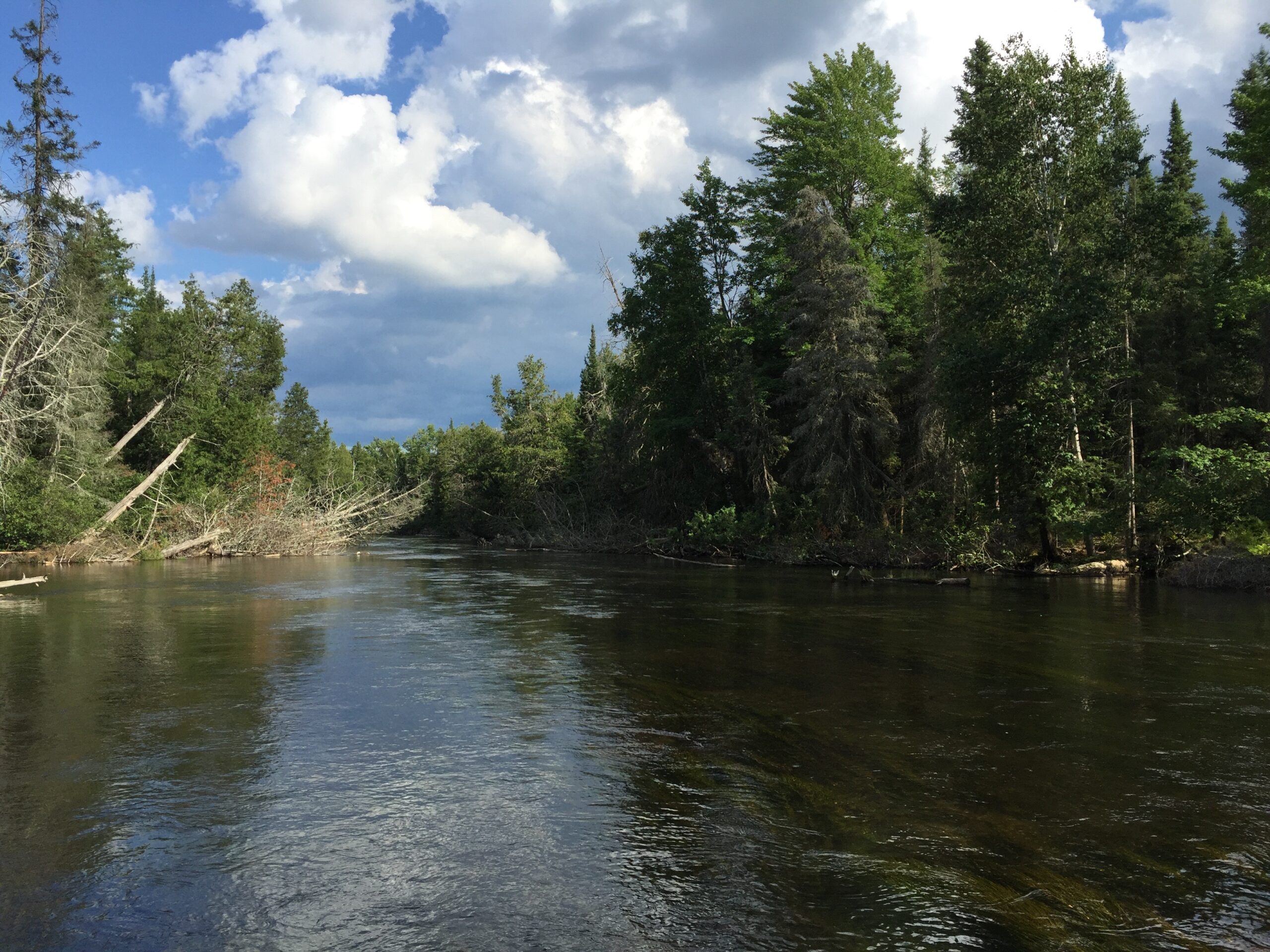
Finally, set the hook if a rise occurs in the area where you think your spinner is- you will not always see you pattern amongst all the naturals and rises going on in feeding pods. It is a very sensory game of telepathy. Also when your spinner pattern hits the water, mend it quickly so you can see the tippet and fly on the surface to locate your spinner. Keep your spinners well lubricated with floatant so they can still ride high after a tight mend.
If your fly is not working try a double pattern like shown above. Most trout are like surface vacuum cleaners during Trico hatches trying to maximize caloric intake as much as they can. A big trout will sip little globs of spinners. Also never fish two spinner patterns together- they will only create drag and surface commotion.
Setting the hook is the real challenge. Do it with a very slow and deliberate downward pointing rod tip to the water and at right angles to the fish’s rise. Let the line tension on the water set the hook. Prepare for a quick run by a larger fish where you must be on your best game of line awareness not wrapped around your hands, reel, packs, boots etc. or “snap and gone” will be the quick outcome. The lighter longer rods will protect the tippets and be very cautious with landing . Also fight the fish with command and dont stress it too much with crazy long battles in summer. Thankfully most tailwaters and spring creeks are ultra cold in summer where that is not the problem. Keep’em wet, enjoy a 3 second snap shot ( have camera/iPhone ready to shoot) and capture your beauty and reward your well earned accomplishment.
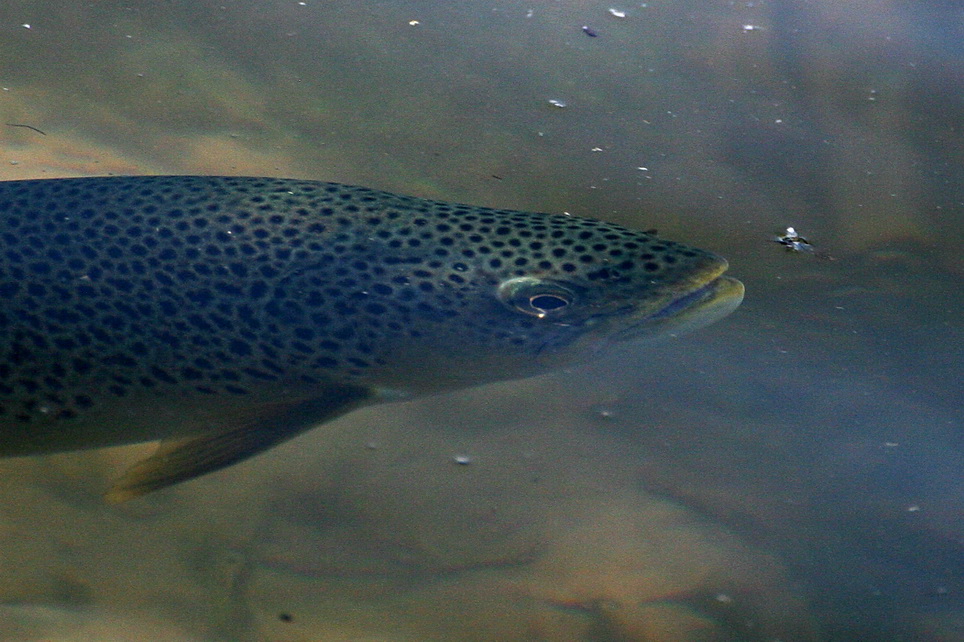
In the end, when all else fails and refusals along with very fussy fish have you feeling down, its time to put on an ant. “Anting the Hatch” , a wonderful piece from the 80’s by a TU member friend Ken Miyata always works and some big trout move over to take a juicy Formicid- brown, black or fiery red. Try it!
Matthew Supinski-Hallowed Waters
( If you enjoyed this piece, Hallowed Waters Podcasts is all about the Trout/Salmon/Steelhead, the holy waters they swim, matching the hatch, the people, experiences and tactical journey that makes fly fishing such a Zen/karma spiritual endeavor. In the next year we are releasing all the Hallowed Waters as glossy print books in a series of chronicles for you to enjoy- our readers and podcast listeners have demanded it!